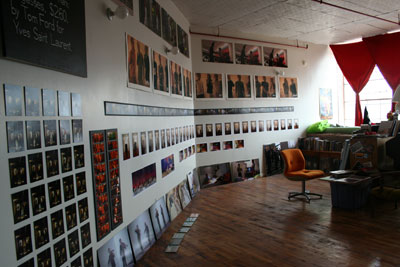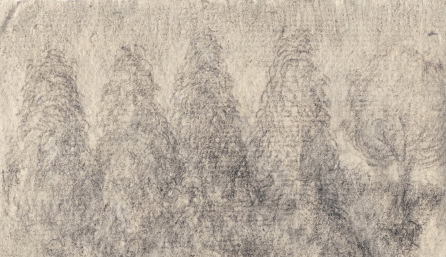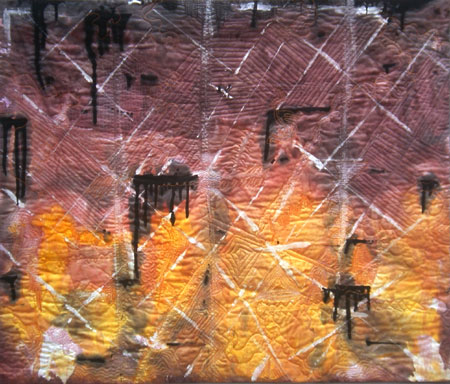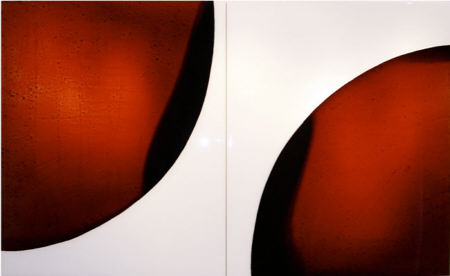Posted by Steve Durbin on June 8th, 2007
This past weekend, I opened the doors of my live/work studio as part of the Bushwick Open Studios and Arts Festival in Brooklyn, New York. It was my first open studio, so I had the opportunity to plaster the walls with my art that had been collecting dust under my bed. The art I hung was the kind of artwork that I considered to be my contribution to the history of art—the work that I would want to be a part of the ‘art world’ and more specifically, artwork that I would submit to galleries for open calls. Here is an example of my open studio space:

more… »
Posted by Karl Zipser on June 6th, 2007

Painting
From Life vs.
From Photos

Traveling makes one aware of constraints of time and space. If I am in Paris today, but I won’t be tomorrow, I need to make the most of the present opportunities.
Painting in the same studio from day to day gives the impression of being in the same place. Working with the same types of materials over time gives a sense of continuity. I’m realizing how much this is an illusion, in the dimension of the art itself.
I can look at older work and enjoy it, but I can’t go back to the “place” I was when I made it — as much as I would like to sometimes. Depending on the type of work and the progress I am making, “old” can mean a year or two weeks. What I am doing on a given day defines a “place” that I found a path to from yesterday. I won’t be able to return most likely. I need to make the most of the place where I am at the moment, then move on.
On this journey an itinerary is not available. If I try to look back or too far ahead, I risk losing my way.
Posted by Doug Plummer on June 5th, 2007

Two recent blog entries, one by Paul Butzi (I’ve been riffing off him a lot lately) on photographing “Close To Home,” and Birgit’s “Dune Quest” have got me thinking about the notational aspects of artmaking. Namely, the daily investigation of ideas and how that relates to projects of “greater” importance.
more… »
Posted by June Underwood on May 25th, 2007

Farmland, 36 x 43, painted cotton
I have lived many places, and in each, I have always had a strong sense of the place itself — the trees and plants, the nature of the cultivated earth, the nature of the uncultivated earth, the sky, winds, air, light — I can describe all these with a fair amount of detail.
But I seldom had to try to recap in art what I know about a place where I no longer live. However, now I am doing so.
“Paint what’s around you,” seems to be a sound admonition, but what is around me is the opposite, environmentally speaking, of what I am painting. more… »
Posted by Doug Plummer on May 21st, 2007
Paul Butzi has a provocative series of posts on Musings, in his typically thoughtful style, about the necessity to seal himself off from influences, particularly the media. I have great respect for his thinking, but I offered a different take in a long comment on his recent post. I’m appropriating myself and posting it here.
Paul,
As I understand you position, you’re saying that in order to protect the integrity of your experience, you have to deliberately isolate yourself from stimulus that might become a mediating influence, because it deters and inhibits the sense of being in the moment.
My retort is twofold, one about artistic influences, and the other about mass media (we won’t talk about the intersection of these two sets, which is an interesting arena that a lot of artists use to make some important work, and always have). I contend that isolating yourself from other artistic influences is a big disservice to one’s own process.
My feeling is, that the more I know about what has gone on before me, the more roots there are to feed my own work. I visit museums and galleries whenever I travel, and I make it a priority. I have arenas of art work that I like to look at and that I respect, and large swaths that I pretty much ignore. But I don’t prohibit it from feeding my process. Even work I argue with grows me.
Allowing Italian Renaissance art into one’s process is one thing. Mass media is harder to defend. But much of the art I adore was the mass media of its era. I am writing this while I am watching my guilty pleasure, “Dancing With The Stars.” I’m working on a dance project. I’m interested in the popular culture take on dance, and I love that this show highlights and rewards a kind of (well, vulgur) virtuosity. Because I make a living from my artistic process, I pay attention to the trends and patterns in how the media mediates our culture back to ourselves.
I don’t like a lot of what I see, of course. That’s beside the point. Anyone with a lick of self respect is going to be majorly frustrated with the culture we live in. The way I inoculate myself from the media onslaught is to pay attention to it. I deconstruct how it works, what it’s trying to say, and the meta messages within it. But sometimes the production values speak to some of the best artistic output of our era. Or at least, it informs me about what is the visual vocabulary of our time.
Posted by Angela Ferreira on May 20th, 2007

Title: Give Peace a Chance
Size: 170 x 78 cm
Medium: Oil on Canvas
Description: Art that changes the World!
Posted by Sunil Gangadharan on May 16th, 2007
I visited a couple of galleries in Chelsea during lunch and one of the galleries that I stopped by was the Merge Gallery where Jordan Eagles is exhibiting his ‘paintings’.

PHASE 1-2; 72″x44″; blood preserved on white Plexiglas, resin
As far as process goes, he uses cow blood trapped between sheets of UV resistant epoxy resin, lets the light play through the myriad textures formed out of the alternating layers of crusted blood of varied thickness and the result is pretty good. When you look at the work closely in person the alternating layers of deep red definitely lends the pieces a strange surreal beauty and looks mesmerizing – turn the lights down and the works start to glow refracting any available light through the layered epoxy resin. I enjoyed it in a surreal sense…
more… »






